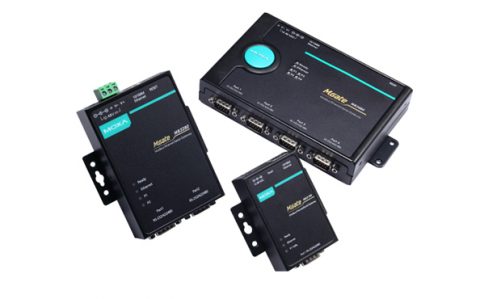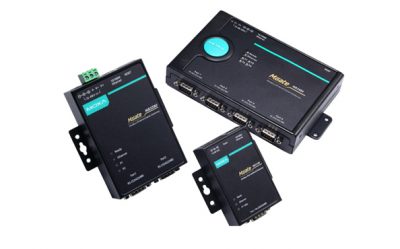MGate MB3180/MGate MB3280/MGate MB3480
1, 2, and 4-port standard serial-to-Ethernet Modbus gateways
- Mô tả Specs Details Overview Components Packages Resources Additional Modules Complementary products Architecture Tools Benefits Features Customer Ordering
- Thông số Specs Details Overview Components Packages Resources Additional Modules Complementary products Architecture Tools Benefits Features Customer Ordering
- Ordering Specs Details Overview Components Packages Resources Additional Modules Complementary products Architecture Tools Benefits Features Customer Ordering
- Tài liệu Specs Details Overview Components Packages Resources Additional Modules Complementary products Architecture Tools Benefits Features Customer Ordering
Features and Benefits
- Supports Auto-Device Routing for easy configuration
- Supports route by TCP port or IP address for flexible deployment
- Convert between Modbus TCP and Modbus RTU/ASCII
- 1 Ethernet port and 1, 2, or 4 RS-232/422/485 ports
- 16 simultaneous TCP masters with up to 32 simultaneous requests per master
- Easy hardware setup and configuration
Overview
The MB3180, MB3280, and MB3480 are standard Modbus gateways that convert between Modbus TCP and Modbus RTU/ASCII protocols. Up to 16 simultaneous Modbus TCP masters are supported, with up to 31 RTU/ASCII slaves per serial port. For RTU/ASCII masters, up to 32 TCP slaves are supported.
Standard Modbus network integration
The three standard MGate™ models (MB3180, MB3280, and MB3480) are designed for easy integration of Modbus TCP and RTU/ASCII networks. With these models, Modbus serial slave devices can be seamlessly incorporated into an existing Modbus TCP network, and Modbus TCP slaves can be made accessible to serial masters. The MB3180, MB3280, and MB3480 offer features that make network integration easy, customizable, and compatible with almost any Modbus network.
High density, cost effective gateway
The MGate™ MB3000 gateways can effectively connect a high density of Modbus nodes to the same network. The MB3280 can manage up to 62 serial slave nodes, and the MB3480 can manage up to 124 serial slave nodes. Each RS-232/422/485 serial port can be configured individually for Modbus RTU or Modbus ASCII operation and for different baudrates, allowing both types of networks to be integrated with Modbus TCP through one Modbus gateway.
Auto-Device Routing for Easy Configuration (Patent Pending)
Moxa’s Auto-Device Routing function helps eliminate many of the problems and inconveniences encountered by engineers who need to configure large numbers of Modbus devices. A single mouse click is all that’s required to set up a slave ID routing table and configure Modbus gateways to automatically detect Modbus requests from a supervisory control and data acquisition (SCADA) system. By removing the need to manually create the slave ID routing table, the Auto-Device Routing function saves engineers significant time and cost.
| • Ethernet Interface | |
| Protocols | Modbus TCP |
| Number of Ports | 1 |
| Speed | 10/100 Mbps, Auto MDI/MDIX |
| Connector | 8-pin RJ45 |
| Magnetic Isolation Protection | 1.5 kV (built-in) |
| • Serial Interface | |
| Protocol | Modbus RTU/ASCII Slave/Master |
| Number of Ports | MB3180: 1 MB3280: 2 MB3480: 4 |
| Serial Standards | RS-232/422/485, software selectable |
| Connectors | DB9 male |
| ESD Protection | 15 kV for all signals |
| RS-485 Data Direction Control | ADDC® (automatic data direction control) |
| • Serial Communication Parameters | |
| Data Bits | 7, 8 |
| Stop Bits | 1, 2 |
| Parity | None, Even, Odd, Space, Mark |
| Flow Control | RTS/CTS, DTR/DSR, RTS Toggle (RS-232 only) |
| Baudrate | 50 bps to 921.6 kbps |
| • Serial Signals | |
| RS-232 | TxD, RxD, RTS, CTS, DTR, DSR, DCD, GND |
| RS-422 | Tx+, Tx-, Rx+, Rx-, GND |
| RS-485-4w | Tx+, Tx-, Rx+, Rx-, GND |
| RS-485-2w | Data+, Data-, GND |
| • Software | |
| Configuration Options | Web Console, Telnet Console, Windows Utility |
| Utility | MGate Manager for Windows 2000, Windows XP, Server 2003, Vista, Server 2008 (x86/x64), Windows Server 2008 R2, Windows 7/8/8.1 (x86/x64), Windows Server 2012 (x64), Windows 2012 R2 |
| Multi-master and Multi-drop | Master mode: 32 TCP slaves Slave mode: 16 TCP masters (request queue 32-deep for each master) |
| Support | Smart Routing, MXview, SNMP v1 (read only) |
| • Physical Characteristics | |
| Housing | Metal, IP30 |
| Weight | MGate MB3180: 340 g (0.75 lb) MGate MB3280: 360 g (0.79 lb) MGate MB3480: 740 g (1.63 lb) |
| Dimensions | Without ears: MB3180: 22 x 52 x 80 mm (0.87 x 2.05 x 3.15 in) MB3280: 22 x 77 x 111 mm (0.87 x 3.03 x 4.37 in) MB3480: 35.5 x 102.7 x 157.2 mm (1.40 x 4.04 x 6.19 in) With ears: MB3180: 22 x 75 x 80 mm (0.87 x 2.95 x 3.15 in) MB3280: 22 x 100 x |
| • Environmental Limits | |
| Operating Temperature | 0 to 60°C (32 to 140°F) |
| Storage Temperature | -40 to 85°C (-40 to 185°F) |
| Ambient Relative Humidity | 5 to 95% (non-condensing) |
| • Power Requirements | |
| Input Voltage | 12 to 48 VDC |
| Input Current | MGate M3180: 200 mA @ 12 VDC MGate M3280: 250 mA @ 12 VDC MGate M3480: 385 mA @ 12 VDC |
| Power Connector | MGate MB3180: Power jack MGate MB3280/3480: Power jack and terminal block |
| • Standards and Certifications | |
| Safety | UL 60950-1, EN 60950-1 |
| EMC | EN 55032/24 |
| EMI | CISPR 32, FCC Part 15B Class A |
| EMS | IEC 61000-4-2 ESD: Contact: 4 kV; Air: 8 kV IEC 61000-4-3 RS: 80 MHz to 1 GHz: 3 V/m IEC 61000-4-4 EFT: Power: 1 kV; Signal: 0.5 kV IEC 61000-4-5 Surge: Power: 1 kV (MB3180/MB3280) IEC 61000-4-5 Surge: Power: 1 kV; Signal: 2 kV (MB3480) IEC 61000-4-6 CS: 150 kHz to 80 MHz: 3 V/m IEC 61000-4-8 PFMF IEC 61000-4-11 |
| • MTBF (mean time between failures) | |
| Time | MGate M3180: 628,376 hrs MGate M3280: 503,029 hrs MGate M3480: 295,812 hrs |
| Standard | Telcordia SR332 |
Available Models
| Model No. | Description | |
|---|---|---|
| MGate MB3180 | 1-port standard Modbus gateway | |
| MGate MB3280 | 2-port standard Modbus gateway | |
| MGate MB3480 | 4-port standard Modbus gateway |
Optional Accessories
 Mounting Kits
Mounting Kits
| Model No. | Description | |
|---|---|---|
| DK35A | DIN-Rail Mounting Kit (35 mm) |
 Connectors
Connectors
| Model No. | Description | |
|---|---|---|
| Mini DB9F-to-TB | DB9 Female to Terminal Block connector |
 Trial Software
Trial Software
| Model No. | Description | |
|---|---|---|
| MXview | Industrial network management software designed for converged automation networks |
New Technology Automates Arduous Routing Setup in Modbus Gateways
When a lot Modbus devices need to be monitored and controlled, engineers usually have to spend a lot of time planning the topology of these devices and segmenting them into different subgroups. Moreover, they are also weighed down by the mundane task of keying in hundreds of Modbus slave IDs to set up each Modbus gateway’s Modbus slave ID routing table. Thus, engineers are constantly on the lookout for solutions that address this pain point when setting up multiple Modbus devices. This white paper takes a closer look at different routing technologies and their pros and cons, as well as a new technology that helps save time and costs when configuring and managing a large number of Modbus devices.
How to Architect Your Systems to Get the Most Out of Your Modbus Devices
The migration of all industrial applications to Ethernet is unquestioned. But, before network engineers can inch closer toward all-systems-go, they need to overcome several challenges. The most pressing one is to ensure that there is no breakdown in communication between serial devices and SCADA hosts. It is no secret that plenty of solutions are available on the market. The immediate question is which solution fits your network’s requirements the best.
In this white paper, we will look at four challenges that arise when linking up Modbus-supported devices to SCADA systems. We will also provide solutions for different scenarios to address your concerns.



